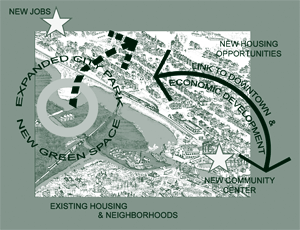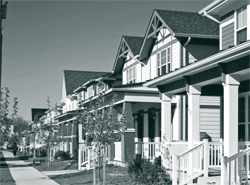July/August 2009
In this Issue
Congress Acts to Boost Confidence, Stability in Housing Market
Home Sharing Makes Housing Affordable
Affordable Housing Revives Historic Neighborhood
Making Fair Housing a Reality
In the next issue of ResearchWorks
Affordable Housing Revives Historic Neighborhood
Using a 2001 HOPE VI grant as a base, the small Frost Belt city of Bridgeton, New Jersey began a revitalization project to give a distressed historic neighborhood a new lease on life. Eight years later, the American Institute of Architects and HUD Secretary Shaun Donovan recognized Bridgeton Neighborhood Revitalization (BNR) with a 2009 Excellence in Affordable Housing Design Award. BNR, a public-private partnership, is composed of the Bridgeton Housing Authority (BHA); architectural firm Torti Gallas and Partners, Inc.; and Ingerman Group, an affordable development and management firm.
The Bridgeton Situation
"Bridgeton is a small city with big city problems," remarked BHA executive director Raymond Maier. Once the county's industrial center, Bridgeton today is the second-poorest city in Cumberland County, according to Maier. The city's median household income is about $33,000, less than half the state median of about $69,000.1 The unemployment rate in Cumberland County, which typically runs several points higher than statewide averages, stood at 12.2 percent in March 2009.2

Revitalization efforts focused on the northern and central areas of the city, the oldest part of Bridgeton, between East Lake and the Cohansey River. The initial planning and urban design efforts that pulled community and local stakeholders together were led by Lindemon Winckelmann Deupree Martin Russell & Associates (LWDMR), laying the groundwork for an ultimately successful HOPE VI application, as well as the additional funding sources. "People had to rethink what it meant to provide well-designed, quality-built, and contextually appropriate affordable housing within New Jersey's largest historic district," commented LWDMR's Eli Martin.
The local partners targeted three noncontiguous groups of blocks containing 217 acres of developable land. A low-income residential neighborhood with small retail businesses, the revitalization area was blighted with empty former industrial properties, such as the old Owens-Illinois glassmaking factory. Vacant lots and interruptions in the street and sidewalk grid discouraged pedestrian traffic and ordinary neighborhood interactions. Much of the housing stock was in poor repair or boarded up. Cohansey View, an existing public housing complex near the river, was outmoded and dysfunctional, ready for demolition.
The revitalization neighborhood, however, also possessed a major attribute: its notable architectural heritage. Bridgeton traces its history back to Colonial times, according to Martin. Like many other modest residential neighborhoods in the old cities of the Northeast, the area had blocks of streetscape with Victorian homes dating back to the late 19th and early 20th centuries. These were houses set in small yards — many of them duplexes that feature peaked roofs, deep porches, and fancy "gingerbread" detailing.
Revitalizing a Neighborhood

BNR took $10.9 million in HOPE VI funds and added $3.1 million in other HUD funding, $862,000 in other public housing funds, and $57.9 million in non-HUD public/private funds. Funders and supporters included the New Jersey Green Acres Program, the Bridgeton Urban Enterprise Zone, Cumberland County, and the city of Bridgeton. HOPE VI construction activities provided about $8.6 million in business to firms located within the city. New housing was primarily built on infill sites or on BHA-owned property.
New construction in the redevelopment area had to meet several potentially competing standards. The homes (rental and owned) had to be affordable for the area's moderate-income residents, with some units reserved for very-low-income residents. The 1,750-square-foot houses had to have specifications similar to market-rate housing, with generous-sized rooms, modern kitchens, and storage space. Materials had to meet demanding safety, sustainability, affordability, and energy-efficiency standards, with tight envelopes, high performance windows, and efficient furnaces. Building materials had to be inexpensive, readily available, and low maintenance.
The HOPE VI area lay next to and partly within Bridgeton’s historic district. All new construction was required to fit in with the historic architectural fabric and be vetted by community stakeholders, adding an additional layer of complexity to the process. Builders used period-style but mass-produced urethane and fiber cement products in place of the traditional high-upkeep wood in creating porch details, cornices, gables, window surrounds, and other decorative elements. At one point, the aesthetic mandate for new construction to harmonize with the upward sweeping lines of the older Victorian housing style came up against the practical need to keep wheelchair-accessible units on one floor. The architects found a solution in the Craftsman style, also commonly found in the historic district, characterized by one-story construction; low-pitched, gabled roofs supported by columns and pedestals; wide overhanging eves; and half or full-width front porches. In addition, all the HOPE VI homes were outfitted with street-level entry and ground floor bathrooms to accommodate wheelchair-bound visitors, according to Maier. Another goal was to make the neighborhood more walkable by planting trees and improving the connectivity of streets and sidewalks. The scattered-site approach adopted by BNR diffused the benefits of redevelopment.
The first families moved into Bridgeton's HOPE VI units (now called Bridgeton Commons) in 2005, with residents of Cohansey View receiving first priority. Construction and occupancy activities were completed in phases, with the final units occupied last year. Today, this affordable development offers 284 rental units, with BHA subsidizing 97 units to make them affordable for very-low-income families. There are 22 single-occupancy units and 18 residences for the handicapped. The nine original homeownership units have already been purchased. In addition, 50 rental units are option-to-buy homes, available for families to purchase after 10 years of residence.
Like other HOPE VI projects, the Bridgeton endeavor included a major programmatic element to foster work readiness, self-sufficiency, and homeownership among residents. Ingerman Group makes an onsite social worker available, along with classes on such topics as personal finance, resume writing, household care and maintenance, and preparation for homeownership. Children’s programs include summer camp, outings, and antigang efforts.
1 Bridgeton New Jersey Real Estate Area Demographics: Summary,
www.clrsearch.com/RSS/Demographics/NJ/Bridgeton/,
accessed May 24, 2009.
2 Bureau of Labor Statistics, www.bls.gov/bls/unemployment.htm, last updated May 8, 2009.

